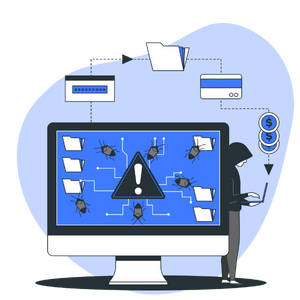Cybersecurity Challenges for Small Businesses, and How to Solve Them
December 31st, 2021 | 4 min. read

Businesses in their first few years are plagued with challenges. You have to think about your cash flow and overhead costs. Unfortunately, with the rise of cybercrime aimed at SMBs, you now also have to worry about cybersecurity for your small business.
According to a study by Verizon, almost half (43%) of cyber attacks target small businesses. That's because cybercriminals know they're the ones least prepared to handle an attack.
In fact, A 2018 Hiscox report found that 65% of small businesses in the US failed to respond properly after an attack. And that is what threat actors are looking for in a mark. The fewer actions you take to secure your network, the easier it is for them to exploit your vulnerabilities. In other words, for hackers, your organization is low-hanging fruit, and it's a juicy one.

At ITS, we've helped hundreds of businesses, big and small, bolster their security efforts. From our experience, small organizations have a few major challenges they need to address if they want to significantly improve their cybersecurity. Thankfully, a reliable managed service provider (MSP) can help.
In this article, we'll discuss the main cybersecurity challenges small businesses face and how to solve them.
How to Solve the Main Cybersecurity Challenges Small Businesses Face?
In a report by the Ponemon Institute, only 14% of small businesses rate their ability to mitigate cyber risks and attacks as highly effective. That means a majority of small organizations believe they are either vulnerable but feel they're unable to do anything about it or that their risk is lower because of their company's size.
Unfortunately, both conclusions are incorrect. Your business is still a target for cybercrime regardless of your size, and there is always a way to mitigate the risk of cyberattacks.
To help you do that, you first need to know the main challenges you're facing when it comes to cybersecurity. Take a look below at the obstacles in your cybersecurity and how to overcome them:
Budget Constraints
 Small businesses need to plan their budget meticulously. Ensuring that your organization has enough to continue operations while paying overhead costs is a tall order. That leaves little left to invest in cybersecurity. According to a study by Insurance Bee, 83% of SMBs have no funds set aside to deal with a cyber-attack.
Small businesses need to plan their budget meticulously. Ensuring that your organization has enough to continue operations while paying overhead costs is a tall order. That leaves little left to invest in cybersecurity. According to a study by Insurance Bee, 83% of SMBs have no funds set aside to deal with a cyber-attack.
Leaving your organization vulnerable so you can save a few bucks could end up costing more than you bargained for. The US National Cyber Security Alliance found that 60% of small businesses that suffer a cyber attack go out of business within half a year. That's because an attack could cost you from $35,000 to just under $200,000 per incident. A hefty sum even for larger organizations.
Investing in your cybersecurity measures is one of the best ways to ensure business continuity and prevent incidents altogether. That means when you plan your budget, you should set some resources aside to protect your network.
How to Solve It:
Industry experts advise that small businesses should set aside a cybersecurity budget worth at least 3% of the company's total spending. That may seem like a lot, but you have to consider that it's not an expenditure; it's an investment. Healthy cybersecurity measures can prevent downtime, data loss, and ransomware incidents which can save you money down the line.
In addition, you can improve cybersecurity by employing good habits in the office. For example, using multi-factor authentication and password managers is an inexpensive way to deter many brute force attacks. In a report by Verizon, 63% of confirmed data breaches take advantage of weak, default, or stolen passwords. Employing good password practices can significantly reduce your chances of a data breach, and it won't cost you much.
If you want more low-cost security tips, you can check out our article on how to improve your cybersecurity on a tight budget.
Mobile Use and BYOD
 The advent of smartphones and bring your own device (BYOD) policies have provided many benefits to small businesses, especially during the pandemic. In a survey conducted by Cisco, 69% of IT decision-makers in the US see BYOD policies in a positive light. That's because it can improve productivity, mobility, and efficiency. But only if it's done right.
The advent of smartphones and bring your own device (BYOD) policies have provided many benefits to small businesses, especially during the pandemic. In a survey conducted by Cisco, 69% of IT decision-makers in the US see BYOD policies in a positive light. That's because it can improve productivity, mobility, and efficiency. But only if it's done right.
Because while it has provided organizations much-needed flexibility and mobility, it has also increased our risk for cyber attacks.
Threats like data leaks and phishing scams have proliferated since teams started migrating from offices to their homes. In fact, a Deloitte report found that 47% more people fall for phishing scams while working from home. That's because there are limitations to how much you can monitor and secure personal devices. It's a lot like opening several doors into your corporate network. Keeping an eye on all entry points will be a challenge.
How to Solve It:
Start small. Test out your BYOD policy with a pilot group, then solicit feedback from them. That way, you can fine-tune your policy into one that fits your needs, and you can consider adequate cybersecurity measures before moving forward.
You can implement employee monitoring software, a virtual private network (VPN), and a firewall to improve security. Those tools can help protect you from potential threats both internally and externally.
You can also choose to partner with a reliable MSP to help you secure, monitor, and manage your team's devices.
Lack of Cybersecurity Expertise
 Cybersecurity experts have become scarce in recent years. In a study by Ninja RMM, three out of four small businesses have admitted that they do not have the necessary IT personnel to handle IT security. In fact, that has become one of the top pain points for many small organizations trying to improve their cybersecurity posture.
Cybersecurity experts have become scarce in recent years. In a study by Ninja RMM, three out of four small businesses have admitted that they do not have the necessary IT personnel to handle IT security. In fact, that has become one of the top pain points for many small organizations trying to improve their cybersecurity posture.
More so than budget constraints, small businesses are struggling to get the right people for the role even when they polled that they were prioritizing cybersecurity and had put aside a budget for it.
That's because there is an ongoing cybersecurity skills shortage that hasn't changed in the past few years. According to the International Organization for Standardization (ISO), 3.5 million cybersecurity jobs were left unfilled this year because of the skills gap. That gap is a major challenge for businesses of all sizes, but for SMBs that might not be able to afford higher salaries, it's near impossible.
How to Solve It:
Aside from matching offers to get top talent, you can leverage on a reliable MSP. You can tap on their resources to gain access to experts in different IT fields, including cybersecurity. Some also offer cybersecurity packages that can provide your network with layers of security that can help keep your business safe.
Related article: What Businesses Need to Know About Managed Cybersecurity Services
Ready to Overcome Your Cybersecurity Challenges?
No matter the size of your business, cybercriminals are an ever-present threat you need to protect against. Thankfully, there's always something you can do about it as long you give priority to your cybersecurity. Whether you need low-cost solutions or a multi-layered security protocol, putting safety first will pay off down the line.
At ITS, we've helped hundreds of businesses improve their cybersecurity efforts. Find out how we can help you. Schedule a meeting with one of our experts.
Mark Sheldon Villanueva has over a decade of experience creating engaging content for companies based in Asia, Australia and North America. He has produced all manner of creative content for small local businesses and large multinational corporations that span a wide variety of industries. Mark also used to work as a content team leader for an award-winning digital marketing agency based in Singapore.
Topics:
